 | ||
Similar Battle of Sekigahara, Genpei War, Jōkyū War, Honnō‑ji incident, Battle of Okehazama | ||
The Ōnin War (応仁の乱, Ōnin no Ran) was a civil war that lasted from 1467 to 1477, during the Muromachi period in Japan. Ōnin refers to the Japanese era during which the war was fought. A dispute between Hosokawa Katsumoto and Yamana Sōzen escalated into a nationwide war involving the Ashikaga shogunate and a number of daimyōs in many regions of Japan.
Contents

The war initiated the Sengoku period, "the Warring States period". This period was a long, drawn-out struggle for domination by individual daimyo, resulting in a mass power-struggle between the various houses to dominate the whole of Japan.
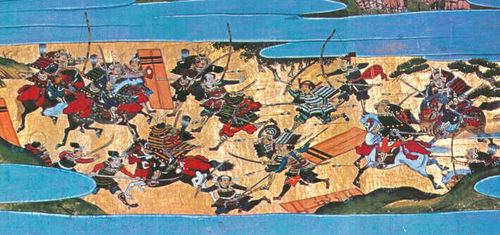
Origin

The Ōnin conflict began as a controversy over who would succeed Shogun Ashikaga Yoshimasa. In 1464, Yoshimasa had no heir. He persuaded his younger brother, Ashikaga Yoshimi, to abandon the life of a monk, and named him heir. In 1465, the unanticipated birth of a son to Yoshimasa put these plans in question. The infant, Yoshihisa, caused friction between the Shogun, Yoshimi, and Hosokawa against Tomiko, the wife of Yoshimasa and mother of Yoshihisa, and Yamana.
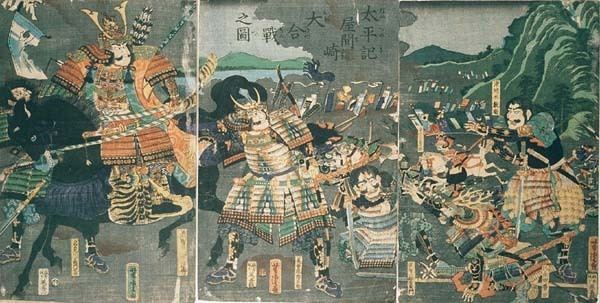
Hosokawa had always worked closely with the Shogun's brother Ashikaga Yoshimi, and supported his claim to the shogunate. Yamana took this as an opportunity to oppose Hosokawa further, supporting the child as heir to the Shogunate. War broke out in the city of Kyoto. This was regarded by the Ashikaga Shogun as an act of rebellion, and thus the Ashikaga and their supporters were forced to try to stop it. The Ashikaga tried to prevent the outbreak of war over the next heir, but the situation escalated into a war that designated the leader of the victorious party as the next shogun. In 1467 the uncertainty had caused a split amongst the warrior clans, and the succession dispute became a pretext for a struggle for military supremacy. In the end, there was no clear-cut winner. The complex array of factional armies simply fought themselves into exhaustion.
Battles
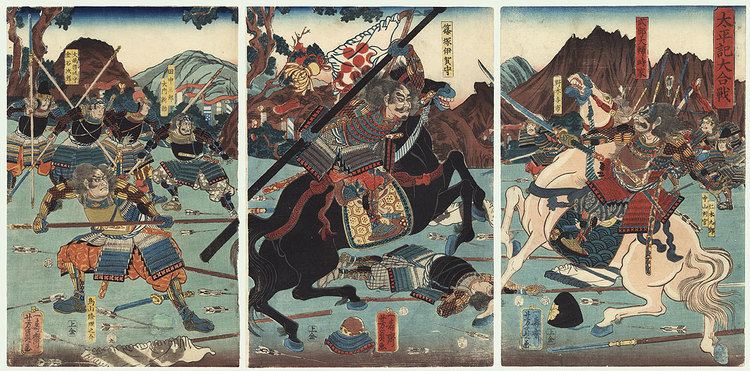
Hosokawa's Eastern Army of about 85,000 and Yamana's Western Army of about 80,000 were almost evenly matched when mobilized near Kyoto. The fighting started in March when a Hosokawa mansion was burned. Then in May 1467, a Yamana mansion was attacked. In July, according to Sansom, Yoshimasa appointed Hosokawa commanding general in an attempt to "chastise the rebel" Yamana. Sansom states "heavy fighting continued throughout July" and "several hundred large buildings were destroyed, and destruction continued day after day." Hosokawa was soon cornered in the northeast portion of Kyoto around his mansion, while Yamana controlled the south and west. Yamana received 20,000 reinforcements under Ouchi Masahiro in Sept. However, Sansom states Hosokawa was able to bring the "sovereign and the abdicated Emperor" to the Bakufu from the Emperor's Palace, before it was seized by Yamana with 50,000 men. Hosokawa then received Akamatsu troops as reinforcements. On 1 November, Yamana was able to capture the Shōkoku-ji after bribing a monk. Sansom states "The chronicles of the time paint a dreadful picture of the carnage," and "the two adversaries faced one another without action for the rest of the year."
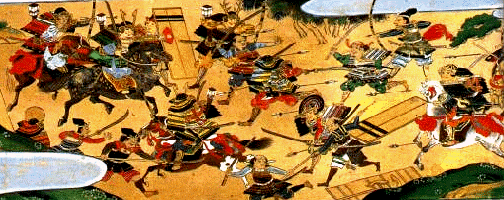
Hosokawa attempted an attack on New Years Day, and then again in April, but for the most part "the two armies now remained glaring at one another month after month." A central trench ten feet deep and twenty feet wide separated the two armies. Several monasteries were burned, including the Tenryū-ji. Finally, Yoshimi went to the side of Yamana, forcing the Shogun to name his son Yoshihisa as his heir in 1469. In a strange switch of allegiances, the war became one of brother against brother. The Emperor Go-Tsuchimikado stripped "Yoshimi of his court ranks" and declared him a rebel.
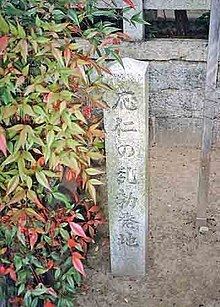
Both Yamana Sōzen and Hosokawa Katsumoto died in 1473, and even then, the war continued on, neither side figuring out how to end the war. However, eventually the Yamana clan lost heart as the label of "rebel" was at last having some effect. Ōuchi Masahiro, one of the Yamana generals, eventually burnt down his section of Kyoto and left the area on 17 December 1477.
By 1477, ten years after the fighting had begun, Kyoto was nothing more than a place for mobs to loot and move in to take what was left. Neither the Yamana clan nor the Hosokawa clan had achieved its aims, other than to whittle down the numbers of the opposing clan.
During this whole ordeal, the shogun was not instrumental in alleviating the situation. While Kyoto was burning, Ashikaga Yoshimasa spent his time in poetry readings and other cultural activities, and in planning Ginkaku-ji, a Silver Pavilion to rival Kinkaku-ji, the Golden Pavilion that his grandfather, Ashikaga Yoshimitsu, had built.
The Ōnin War, and the shogun's complacent attitude towards it, "sanctioned" private wars and skirmishes between the other daimyōs. No part of Japan escaped the violence. Although the battles in Kyoto had been abandoned, the war had spread to the rest of Japan. In Yamashiro Province, the Hatakeyama clan had split into two parts that fought each other to a standstill. This stalemate was to have serious consequences. In 1485, the peasantry and jizamurai (lesser samurai – mostly armed peasants) had had enough, and revolted. Setting up their own army (the Ikki), they forced the clan armies to leave the province. The Ikki became a powerful force, much more than simply an armed mob. By 1486 they had even set up a provisional government for Yamashiro province.
The Ikki would form and appear throughout other parts of Japan, such as Kaga Province, where a sect of the Jōdo Shinshū Buddhists, the Ikkō, started their own revolt during the Ōnin War after being enlisted by one of Kaga's most prominent warlords, Togashi Masachika. The Ikkō, who had a complex relationship with the Jodo Shinshu leader Rennyo, appealed to the common peasants in their region, and inevitably formed the Ikkō-ikki. By 1488 the Ikkō-ikki of Kaga Province overthrew Masachika and took control of the province. After this they began building a fortified castle-cathedral along the Yodo River and used it as their headquarters.
The Ikkō-ikki and the Yamashiro-ikki part of the general outbreak of civil war. Sansom states some refer to this as gekokujō (roughly "the low oppress the high"), or a "disturbed social order". Sansom further states, "The frequent risings of the fifteenth century were expressions of popular discontent in which peasants took part".
Aftermath
After the Ōnin War, the Ashikaga bakufu completely fell apart; for all practical purposes, the Hosokawa family was in charge and the Ashikaga shoguns became their puppets. When Yoshimi's son Yoshitane was made shogun in 1490, the Hosokawa Kanrei (deputy) soon put him to flight in 1493 and declared another Ashikaga, Yoshizumi, to be shogun. In 1499, Yoshitane arrived at Yamaguchi, the capital of the Ōuchi, and this powerful family threw its military support behind Yoshitane. In 1507, the Kanrei Hosokawa Masamoto was assassinated and in 1508, Yoshizumi left Kyoto and the Ōuchi restored the shogunate to Yoshitane. Thence began a series of strange conflicts over control of the puppet government of the shogunate. After the death of Hosokawa Matsumoto, his adopted sons Takakuni and Sumimoto began to fight over the succession to the Kanrei, but Sumimoto himself was a puppet of one of his vassals. This would characterize the wars following the Ōnin War; these wars were more about control over puppet governments than they were about high ideals or simply greed for territory.
The Hosokawa family would control the shogunate until 1558 when they were betrayed by a vassal family, the Miyoshi. The powerful Ōuchi were also destroyed by a vassal, Mōri Motonari, in 1551.
By the end of the Warring States Period only a dozen or so warlord families still remained standing. But the most important development to come out of the Ōnin War was the ceaseless civil war that ignited outside the capital city. Hosokawa tried to foment civil strife in the Ōuchi domains, for instance, and this civil strife would eventually force Ōuchi to submit and leave. From the close of the Ōnin War, this type of civil strife, either vassals striving to conquer their daimyo or succession disputes drawing in outside daimyo, was endemic all throughout Japan.
Scholars disagree on the appropriateness of the term "Warring States period" (which is the Chinese term borrowed by the Japanese in calling this period "sengoku jidai"). Many argue that since Japan was essentially intact, the Emperor and shogunate remaining at least nominally in command of the whole country, it really wasn't a "warring states" period at all, but a "warring warlords" period. However, others such as Mark Ravina, Mary Elizabeth Berry, and Conrad Totman argue that the kuni (provinces) were not unlike quasi-independent states, and that the term is thus more or less appropriate.
The cost for the individual daimyo was tremendous, and a century of conflict would so weaken the bulk of Japanese warlords, that the three great figures of Japanese unification, beginning with Oda Nobunaga, would find it easier to militarily assert a single, unified military government.
Kyoto
Kyoto was devastated by the war, not really recovering until the mid-16th century. The city has not seen such widespread destruction since, being spared the strategic bombing of Japanese cities during World War II. In Kyoto, "pre-war" refers to the Ōnin War, rather than WWII.
Ōnin Ki
The Ōnin Ki (応仁記) is a document written sometime from the end of the 15th century to the middle of the 16th century (i.e. some 20 to 80 years after the conflict), which describes the causes and effects of the Ōnin War. It illustrates in detail the strategies involved in the fighting, and its chief instigators, Yamana Sōzen and Hosokawa Katsumoto.
Though it is classified as a work of historical military fiction (軍記物語), because of the time in which it was written, it is entirely possible that the author is relating a first person account of the conflagration. Though its author is unknown, his beliefs and philosophies are apparent throughout the text, as he relates the apparent futility of the war and the destruction it wrought on the capital. It remains an important work in part due to its departure from somewhat cut-and-dried depictions of the numerous battles, instead adding accounts of how the Onin War affected the city and its citizens:
"The flowery capital which we thought would last forever to our surprise is to become a lair of wolves and foxes. Even the North Field of Toji has fallen to ash ... Lamenting the plight of the many fallen acolytes, Ii-o Hikorokusaemon-No-Jou read a passage:
Nare ya shiru
Miyako wa nobe no
Yu-hibari
Agaru wo mite mo
Ochiru na-mida wa
Now the city that you knew
Has become an empty moor,
From which the evening skylark rises
While your tears fall."
Chronology
The origins of the Ōnin conflict are manifold. To say that the war began with a quarrel between angry warlords is too simplistic. The initial phase of this decade-long struggle "was only a spark which set fire to a broader conflagration." Without fully anticipating the consequences, the Kamakura government had loosened the restraints of tradition in Japanese society, which meant that "new energies were released, new classes were formed, and new wealth was created." As the shogunate's powerful figures competed for influence in Kyoto, the leading families in the provinces were amassing resources and growing more independent of centralized controls.
Precursors
Warfare begins
Sequel
